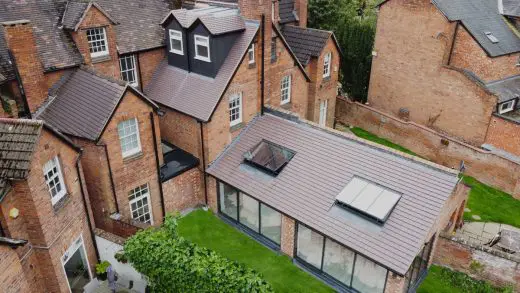Rooflights and what to look out for in the specification process, Modular skylights types, Building windows
Rooflights Specification Process Advice Guide
post updated 16 June 2025
U-WHAT?!
Paul Trace from Stella Rooflight helps readers understanding the thermal performance (U-values) of rooflights and what to look out for in the specification process.
One of the most important elements of modern building materials is thermal performance, which is measured in terms of heat loss. In the construction industry this is commonly expressed as a U-value or even sometimes an R-value. U-value calculations will invariably be required early on in the building strategy stage as it provides an indication as to how much heat loss a building is likely to suffer upon completion. The products used in the build are normally required to be tested and a figure for each component given. One example of where this is an essential requirement is rooflights.
3 July 2024
Rooflights and what to Look Out for in the Specification Process
Thermal transmittance (U-value) is measured in units of W/m²K which stands for Watts/meter square Kelvin. The lower the U-value the more efficient the construction is at keeping heat flow through the structure to a minimum. It is worth noting that it’s not just the building materials and products that have an impact on the thermal performance of a building, as both workmanship and installation standards can strongly affect the thermal transmittance. If insulation is fitted poorly, with gaps and cold bridges, then the thermal transmittance can be considerably higher than desired, no matter how good the individual products are.
Thermal transmittance takes heat loss due to conduction, convection and radiation into account. The amount of heat conducted through a material of a given volume, in a unit of time i.e. the rate of conduction is why the units are measured as W/K.
There are guidelines in the UK, set out in Building Regulations Approved Document Part L (Conservation of Fuel and Power), that give the maximum U-value that materials and structures are allowed to have in a range of buildings, including domestic properties. It sets a national standard to ensure that homes must be built to a certain performance level of energy efficiency for both the reduction of carbon emissions and the reduction of residents heating bills.
A U-value is one of the most difficult thermal measurements to calculate and so it is important that any figures are produced using reliable software from a bona fide source. When it comes to rooflight suppliers providing U-value figures for their products, rooflight manufacturers all want the lowest possible number to prove that their rooflights give the best thermal performance, which ultimately reduces heat loss for their customers. In the rush to be the best, it is not inconceivable that figures get a little massaged so it is always best to ask for a copy of the test performance report to ensure that a) the figures are genuine and b) that the figures were produced in the correct way.
Despite them being used in their millions across the country, you might be surprised to find out that there is no specific test for a rooflight. Instead rooflights are tested to BS EN ISO 10077-1:2017, which is a thermal performance test for windows, doors and shutters.
So does this actually matter? Well, actually yes it does because most rooflights cannot be used in the same way as windows and this will result in a change to the U-value. For example, the pitch of the roof will change the thermal performance of your rooflight. However, the testing of rooflight performance is based on either a vertical (above 60 degrees) or horizontal (0 degree) pitch. Both of these positions are usually outside the maximum and minimum pitch that rooflight manufacturers recommend for their rooflight products.
There is quite a bit of difference in the U-values given to rooflights at both ends of the scale. Some rooflights, for example, might achieve a U-value of 1.5 W/m²K in the horizontal position but this can improve to 1.1 W/m²K when used above 60 degrees. Now when you ask most companies what the U-value is for their rooflight which figure do you think you will be given? This is why it is important to either ask for both figures or to request data to support the figures quoted.
The design of a rooflight is also critical to the thermal performance. Most modern rooflights are produced from thermally broken aluminium, which is then clad internally with wood to provide very good U-values. Whilst making the frames more thermally efficient, this approach also makes the rooflights chunky, which often results in them sticking several inches above the roofline and providing poor frame to glass ratios. It is not uncommon for some rooflight frames to make up over 40% of its overall size, which ultimately means 40% less light entering a building.
One of the easiest ways to lower a U-value on a window or rooflight is to increase the thickness of the glazing. A decent double glazed unit will give a centre pane value of 1.0W/m²K and a triple around 0.5W/m²K. Then of course there are some that offer quad glazing, which reduces this figure further. However, it should also be noted that by reducing the U-value in this way, you will be significantly increasing the weight of the product, the cost and also the depth of the rooflight profile.
If you are working on a Listed Building or in a Conservation area then you will require a conservation rooflight design, which should sit completely flush with your roofline. If you are looking to use quad glazing or modern bulky rooflights to improve thermal performance then this will most certainly be to the detriment of the buildings aesthetics.
There are a few exceptions relating to the thermal requirements in certain buildings and it is always a good idea to take professional advice should your project fall into one of the following categories:
- Where the replacement roof windows are unable to meet the requirements because of the need to maintain the external appearance of the façade or the character of the building, replacement windows should meet a centre pane U-value of 1.2 W/m2K.
- Buildings which are; Listed in accordance with section 1 of the Planning (Listed Buildings and Conservation Areas) Act 1990; In a conservation area designated in accordance with section 69 of that Act; or Included in the schedule of monuments maintained under section 1 of the Ancient Monuments and Archaeological Areas Act 1979; Carports.
- Buildings which are; Listed in accordance with section 1 of the Planning (Listed Buildings and Conservation Areas) Act 1990; In a conservation area designated in accordance with section 69 of that Act; or Included in the schedule of monuments maintained under section 1 of the Ancient Monuments and Archaeological Areas Act 1979; Used primarily or solely used as places of worship; Stand-alone buildings with floor area less than 50m2; Carports; Temporary building with a planned time of use less than 2 years.
In conclusion, despite the fact that the testing methods for obtaining a rooflight’s thermal performance could do with an overhaul, a U-value figure can be important when both choosing products and in the overall construction of your property. The lower the figure the more thermally efficient a product or building is and this can contribute to reducing heating costs.
It is also important that the figures provided are genuine and it is advisable to request proof that U-values being quoted are not only correct but are applicable for the application that you are using that product.
For more information download ‘The Ultimate Guide to Conservation Rooflights’ – an independent guide to everything you need to know about specifying conservation rooflights – available exclusively on the Stella Rooflight website.
To find out more about Stella conservation rooflights visit: https://stellarooflight.co.uk
About Stella Rooflight
Stella Rooflight is a bespoke manufacture of high quality stainless steel rooflights. From design and production through to customer service, Stella has a single vision of doing things better than the industry standard.
Stella produces exceptional rooflights that combine a flush fitting profile, while utilising the very best of materials, and has become the first choice for discerning clients looking to bring natural daylight into their living spaces through premium quality rooflights.
01794 745445
Comments on this guide to What is a Rooflights and what to Look Out for in the Specification Process article are welcome
Architectural Products
Architectural Glass Products & Systems – Selection
Architectural Designs
Contemporary Architecture in Dubai – architectural selection below:
Apple Campus 2, Cupertino, CA, USA
Design: Foster + Partners with Arup
Apple Campus 2
Swiss Re, London, UK
Swiss Re Building – The Gherkin : London skyscraper
, Dubai, United Arab Emirates
Architects: Populous
Coca-Cola Arena
Comments / photos for the Rooflights and what to Look Out for in the Specification Process page welcome.








